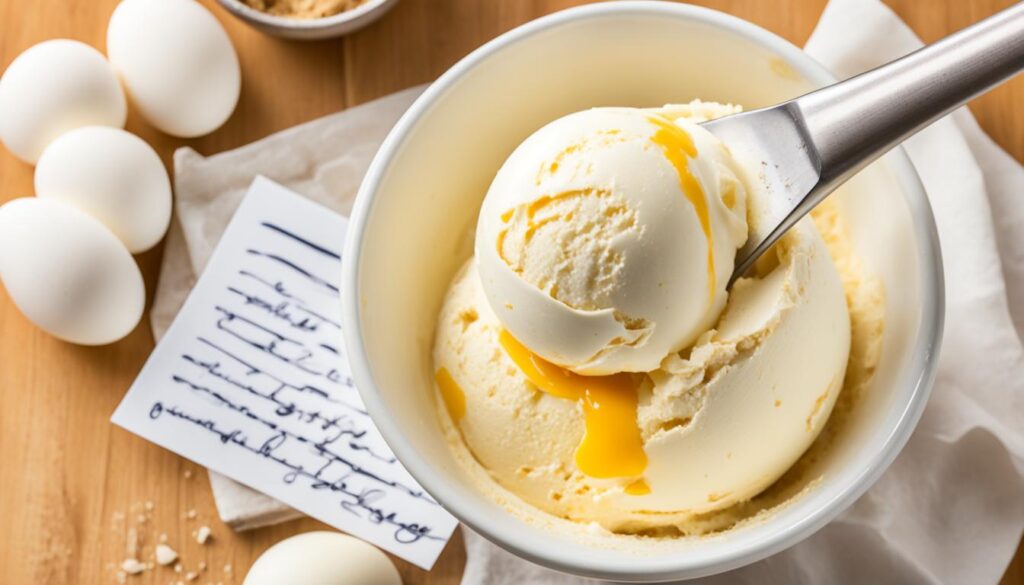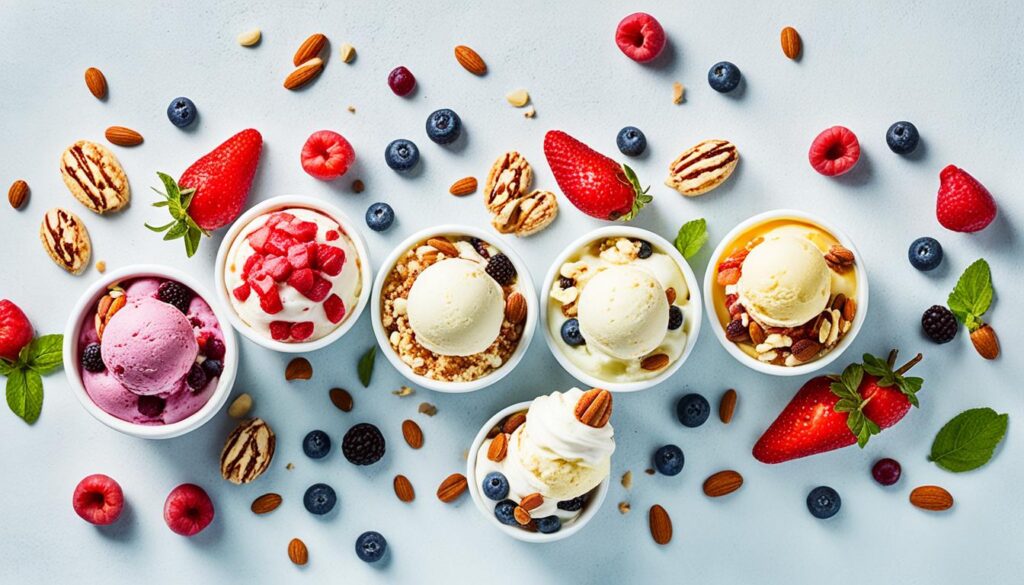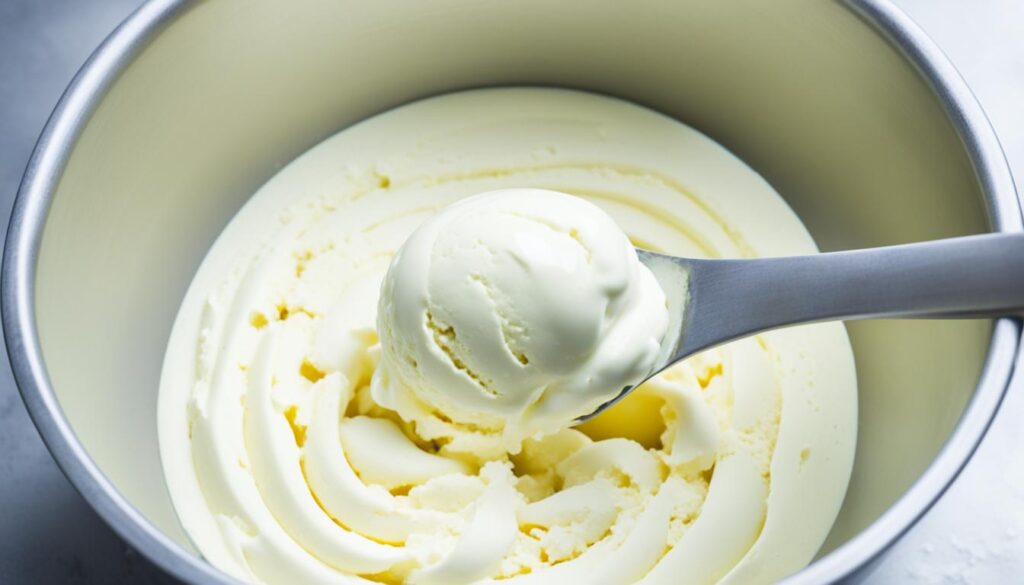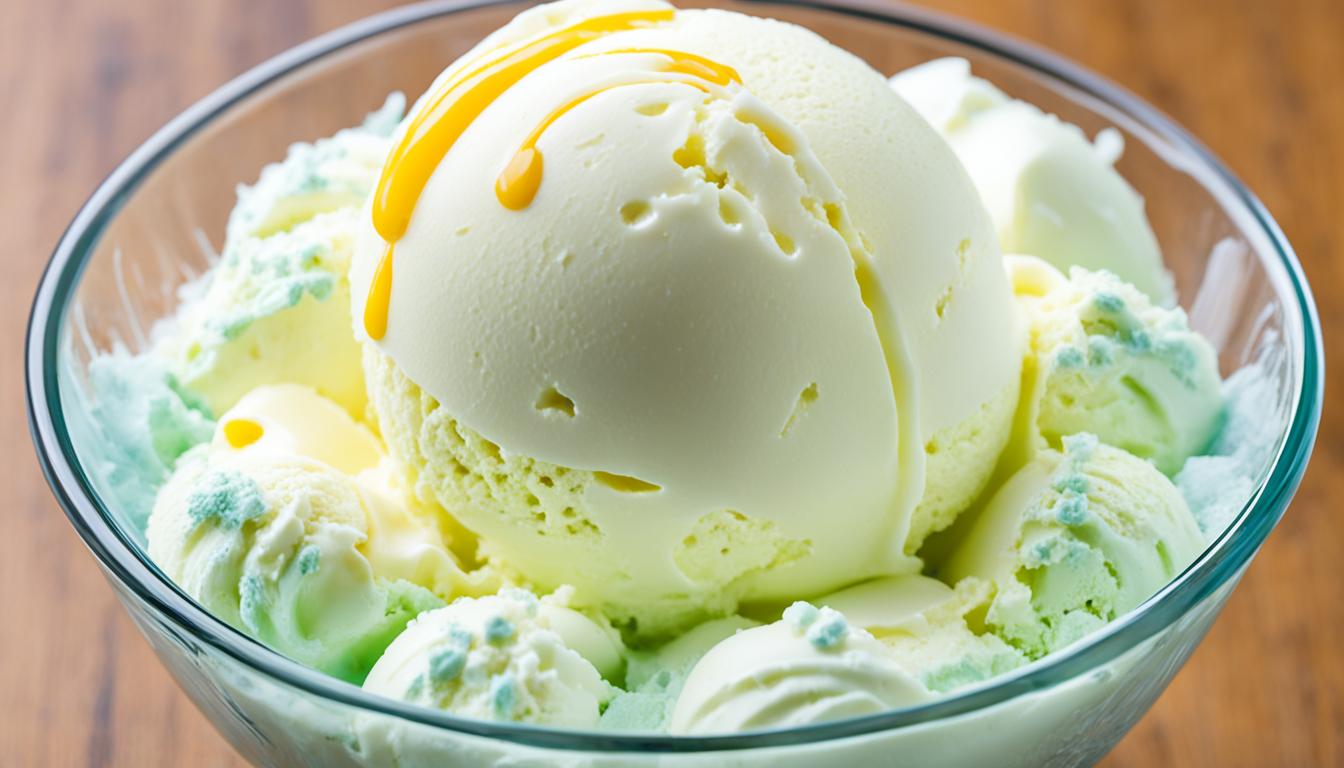How many eggs should I use to make ice cream? It’s a question that has sparked countless debates among dessert enthusiasts. Some swear by a minimal amount of eggs, while others insist on a generous quantity. But what is the perfect egg ratio for achieving the smoothest, richest homemade ice cream?
Eggs play a crucial role in ice cream making, contributing to the texture, flavor, and stability of the final product. They add richness and creaminess to the ice cream, help prevent the formation of chunky ice crystals, and serve as emulsifiers to bind fat and water together. But the ideal quantity of eggs can vary depending on the specific flavor and desired outcome.
In this article, we will delve into the science behind eggs in ice cream, explore the role they play in flavor development, and even discuss adaptations for those who prefer eggless recipes. Get ready to discover the secrets to crafting the perfect egg ratio for creamy ice cream making!
Key Takeaways:
- The ideal egg ratio for homemade ice cream depends on personal preference and the desired outcome of the ice cream.
- Eggs contribute to the texture, flavor, and stability of ice cream by adding richness, creaminess, and emulsification properties.
- Experimenting with different egg ratios can help achieve the perfect balance of flavor and texture in homemade ice cream.
- For those who prefer eggless ice cream recipes, there are various adaptations and alternative ingredients that can be used to achieve a creamy texture.
- Properly tempering the eggs, cooking the custard to the right consistency, and chilling thoroughly before churning are crucial steps in making homemade ice cream.
The Science Behind Eggs in Ice Cream
Egg yolks play a vital role in creating the smooth, creamy texture that makes ice cream so irresistible. Their unique composition, high in fat and protein, contributes to the luxurious mouthfeel and velvety consistency of egg yolk ice cream and egg custard ice cream. Let’s explore the science behind how eggs work their magic in homemade ice cream.
The fat content in egg yolks lends richness and adds a silky smoothness to the ice cream. When frozen, these fats remain soft, which helps prevent the formation of large ice crystals and results in a creamier texture. The proteins in egg yolks also play a crucial role; they form a mesh-like structure that traps water molecules, further enhancing the smoothness of the ice cream.
But it doesn’t stop there. Egg yolks contain emulsifiers, such as lecithin, that act as natural stabilizers. These emulsifiers help bind the fat and water together, creating a homogenous mixture that improves the overall texture and mouthfeel of the ice cream. This creamy emulsion adds body and richness, making egg-based ice creams truly indulgent.
Furthermore, egg yolks are the key ingredient in creating custard-based ice creams. In a custard, the eggs are cooked with dairy to create a thick and smooth base. This method allows for even more control over the texture and richness of the ice cream, resulting in an exceptionally velvety and decadent treat.
As you can see, eggs bring a unique combination of fat, protein, and emulsifiers to the table when it comes to homemade ice cream. They contribute to the smoothness, creaminess, and richness that we all love in a perfect scoop. Now that we understand the science behind eggs in ice cream, let’s explore how to adapt recipes for different flavors and textures in the next section.
The Role of Eggs in Ice Cream Flavor
In addition to contributing to the texture of ice cream, eggs also add flavor to the final product. The egg yolks lend a rich and custardy note to the ice cream, which is particularly desirable in classic flavors like vanilla. However, it is important to note that eggs can overshadow subtle flavors in the ice cream, so their use should be considered based on the desired flavor profile. Those who prefer eggless ice cream recipes can explore alternative methods and ingredients to achieve a creamy texture and unique flavor combinations.
Adjusting Egg Ratios for Flavored Ice Creams
When it comes to making flavored ice creams, finding the perfect balance of ingredients is essential. In particular, adjusting the egg ratios in your homemade ice cream base can greatly impact the final flavor and texture. Let’s dive into some tips on how to achieve the best results.
Higher Egg Ratios for Rich Flavors
Rich and decadent flavors like chocolate or peanut butter can benefit from higher egg ratios in the ice cream base. The addition of eggs enhances the creaminess and body of these indulgent Ice creams. The richness of the eggs complements the intensity of the flavors, resulting in a harmonious and delightful taste experience.
Lower Egg Ratios or Eggless Options for Fruit-based Flavors
For fruit-based flavors, it is often best to use fewer eggs or even explore eggless recipes. The vibrant and delicate flavors of fruits can be overpowered by the richness of eggs. By reducing the number of eggs or opting for eggless alternatives, you allow the fruity notes to shine through, creating a refreshing and more fruit-forward ice cream.
To help you visualize the different egg ratios suitable for flavored ice creams, we have created a table showcasing some popular flavor combinations:
| Flavor | Egg Ratio |
|---|---|
| Chocolate | 4-6 eggs per quart |
| Strawberry | 2-3 eggs per quart or eggless |
| Peanut Butter | 4-6 eggs per quart |
| Mango | 1-2 eggs per quart or eggless |
Experimenting with different egg ratios can help you find the perfect balance of flavors and textures for each unique ice cream creation. Whether you prefer a rich and velvety chocolate ice cream or a light and fruity strawberry sorbet, adjusting the egg ratios allows you to customize your homemade ice cream to match your taste preferences.

Experimenting with different egg ratios can lead to mouthwatering ice cream creations.
The Impact of Egg Yolk Quantity on Ice Cream Texture
The number of egg yolks used in an ice cream recipe can significantly impact its texture. In a series of taste tests, ice creams with a higher number of egg yolks were found to be creamier and slower to melt, thanks to the thick gel formed by the coagulated proteins. The creaminess and density of these eggier ice creams provide a more indulgent and satisfying mouthfeel. However, it is important to note that personal preferences vary, and some individuals may prefer ice creams with fewer egg yolks, which may have a lighter and icier consistency. Ultimately, the choice of egg yolk quantity depends on personal taste and the desired texture.
To better understand the relationship between egg yolk quantity and ice cream texture, let’s take a closer look at the science behind it. The proteins in egg yolks, such as ovalbumin and conalbumin, coagulate when heated, forming a thick gel-like matrix. This gel structure helps trap and hold water molecules, preventing the formation of large ice crystals and giving the ice cream a smoother texture. The higher the quantity of egg yolks, the more coagulated proteins there are, resulting in a denser and creamier ice cream.
One popular example of egg yolk ice cream is the classic French vanilla. This iconic flavor showcases the rich and velvety texture that can be achieved with a higher number of egg yolks. The yolks not only contribute to the creaminess but also enhance the flavor profile, adding a custardy note that complements the sweetness of the ice cream base.
On the other hand, some individuals may prefer ice creams with fewer egg yolks or even eggless alternatives. Ice creams with fewer yolks can have a lighter and icier consistency, which may be desirable for those who prefer a less rich or heavy dessert. Additionally, eggless recipes can cater to dietary restrictions or personal preferences, allowing for a broader range of flavor combinations and adaptations.
“The creaminess and density of eggier ice creams provide
a more indulgent and satisfying mouthfeel.”
It’s important to note that the impact of egg yolks on ice cream texture is not limited to custard-based recipes. Even in non-custard-style ice creams, where eggs are used in smaller quantities, they can still contribute to the overall texture and stability of the dessert. Experimenting with different egg yolk quantities allows for a customized approach to ice cream making, tailoring the recipe to personal preferences and desired outcomes.
To summarize, the number of egg yolks used in an ice cream recipe has a direct influence on its texture. More yolks result in a creamier and denser consistency, while fewer yolks or an eggless approach can create a lighter and icier texture. The choice of egg yolk quantity ultimately depends on personal taste and the desired mouthfeel. So whether you prefer a luxuriously rich ice cream or a lighter treat, adjusting the egg yolk quantity can help you achieve the perfect texture in your homemade ice cream creations.
Recipe Adaptations for Eggless Ice Cream
For those who prefer or require eggless ice cream recipes, we have alternatives that can still achieve a creamy texture. By using a base of coconut milk or cashew cream, incorporating stabilizers like cornstarch or agar-agar, or adding ingredients such as avocado or banana for natural creaminess, you can create delicious and satisfying eggless ice cream. These adaptations offer a range of possibilities for those with dietary restrictions or personal preferences.
If you’re looking for a dairy-free option, coconut milk serves as an excellent base for creamy ice cream. Its natural fat content provides richness and a smooth texture. Cashew cream, made by blending soaked cashews with water, creates a luxurious and creamy base for your ice cream.
Stabilizers can also be added to achieve a creamy texture in eggless ice cream. Cornstarch, when heated and combined with a liquid, acts as a thickening agent and enhances the mouthfeel. Agar-agar, a plant-based gelatin substitute, is another option that creates a smooth and creamy texture when used in the right proportion.
Adding ingredients like avocado or banana can contribute to the natural creaminess of eggless ice cream. Avocado’s high fat content and smooth texture make it an ideal ingredient for creating creamy ice cream without eggs. Bananas, when frozen and blended, provide a creamy base and add natural sweetness to your ice cream recipes.
Exploring eggless ice cream recipes offers a great opportunity to get creative in the kitchen and create frozen treats that cater to your specific dietary needs or personal preferences. Give these adaptations a try and discover the delicious possibilities of eggless ice cream!

Next, we’ll delve into the question of whether there is a magic egg-to-dairy ratio that applies to all ice cream recipes. Join us as we explore the various factors to consider when determining the perfect ratio for your homemade ice cream.
Is There a Magic Egg-to-Dairy Ratio?
While there is no definitive magic egg-to-dairy ratio that applies to all ice cream recipes, it is important to consider the overall composition and specific flavors of the ice cream base. A custard-based ice cream, typically made with a higher quantity of eggs, will result in a denser and more indulgent texture. On the other hand, a simpler Philadelphia-style ice cream, made without eggs, will be lighter and less rich. The ideal egg-to-dairy ratio depends on personal preference and the desired outcome of the ice cream. Experimenting with different ratios and flavor combinations can help you discover your perfect egg ratio for creamy ice cream making.

Egg-to-Dairy Ratios for Different Ice Cream Bases
| Ice Cream Base | Egg-to-Dairy Ratio | Texture |
|---|---|---|
| Custard-based (with eggs) | 1:2 to 1:3 (1 egg: 2 to 3 cups of dairy) | Denser and more indulgent |
| Philadelphia-style (without eggs) | 0:1 (no eggs) | Lighter and less rich |
Homemade Ice Cream Tips and Tricks
When it comes to making homemade ice cream with eggs, there are a few tips and tricks that can ensure success. We want to help you create the perfect creamy and delicious ice cream every time. Here are some expert techniques to elevate your homemade ice cream game:
1. Properly Temper the Eggs
Tempering the eggs is essential to avoid scrambling them and achieve a smooth custard. Begin by slowly adding a small amount of the hot liquid (usually a warm dairy mixture) to the beaten eggs while whisking continuously. Gradually incorporating the hot liquid helps bring the eggs to a similar temperature, preventing them from cooking too quickly when added to the hot mixture.
2. Cook the Custard to Perfection
The cooking process is crucial for achieving the desired texture in your homemade ice cream. Cook the custard over medium heat, stirring constantly, until it thickens. This ensures that the eggs are fully cooked and the mixture reaches the proper consistency for a creamy and smooth ice cream base.
3. Thoroughly Chill the Custard
To achieve a consistent freeze and a smooth, velvety texture, it’s imperative to chill the custard thoroughly before churning. Allow the custard to cool completely in the refrigerator for a few hours or overnight. This step also helps the flavors meld together for a more pronounced taste.
4. Prevent Ice Crystal Formation
To prevent the formation of undesirable ice crystals, cover the surface of the ice cream with plastic wrap before placing it in the freezer. This protective layer helps preserve the texture and maintain the overall quality of your homemade creation.
“Following these techniques and experimenting with different flavors and egg ratios will help you create the perfect homemade ice cream.”
By following these tips and tricks and experimenting with flavors and egg ratios, you’ll be well on your way to creating luscious, homemade ice cream that rivals the best ice cream parlors. Enjoy the delightful process and savor each delectable scoop of your classic egg ice cream masterpiece!
Get ready to impress your family and friends with your culinary skills as you master the art of making homemade ice cream.
Conclusion
The ideal number of eggs to use in homemade ice cream is subjective and depends on personal preference and the desired outcome. Eggs play a crucial role in enhancing the texture, flavor, and stability of the ice cream. They contribute richness and creaminess, while also acting as emulsifiers to bind fat and water together. However, there is no one-size-fits-all answer to the question of how many eggs to use.
The egg-to-dairy ratio can vary depending on the specific flavor and desired texture of the ice cream. Some recipes may call for a higher number of eggs, resulting in a denser and more indulgent ice cream. Others may opt for fewer eggs or even explore eggless options for a lighter and fruitier taste. The key to finding the perfect egg ratio for your creamy ice cream lies in experimentation and trying out different ratios and flavor combinations.
To make your own delicious homemade ice cream, grab those eggs, get creative, and enjoy the process. Whether you prefer a classic egg custard ice cream or an eggless alternative, there are countless possibilities to explore. So go ahead, indulge in the world of homemade ice cream making, and discover the perfect egg ratio that satisfies your taste buds.
